The Home Security Drone Market is estimated to be valued at USD 1011.1 million in 2025 and is projected to reach USD 3432.1 million by 2035, registering a compound annual growth rate (CAGR) of 13.0% over the forecast period.
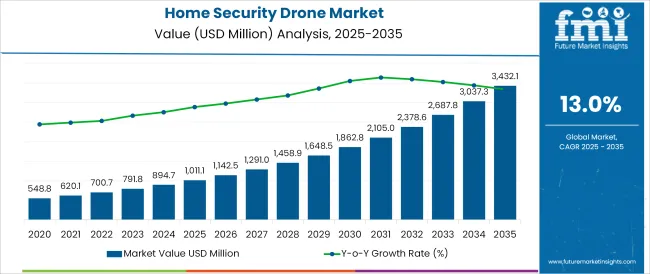
The home security drone market is gaining momentum, driven by rising concerns over residential safety and advancements in autonomous surveillance technologies. Industry updates and technology firm press releases have highlighted the increasing integration of drones into smart home ecosystems, enabling real-time perimeter monitoring and threat detection.
Manufacturers have enhanced product capabilities with features such as night vision, motion tracking, and automated return-to-base functionalities. Additionally, consumer interest in wireless and app-controlled security solutions has fueled adoption in both urban and suburban residential areas.
Investments in lightweight, battery-efficient drones have further expanded their appeal for household use. As privacy and safety awareness grows, homeowners are seeking proactive surveillance measures beyond traditional static cameras. Future market growth is expected to be supported by improvements in obstacle avoidance technology, AI-driven anomaly detection, and seamless integration with home automation platforms. Segmental leadership is being driven by Rotary-wing Drones for their maneuverability and Outdoor applications, where the need for real-time monitoring of open areas is most pronounced.
The market is segmented by Drone Type and Application and region. By Drone Type, the market is divided into Rotary-wing Drone, Fixed-wing Drone, and Hybrid Drone. In terms of Application, the market is classified into Outdoor and Indoor. Regionally, the market is classified into North America, Latin America, Western Europe, Eastern Europe, Balkan & Baltic Countries, Russia & Belarus, Central Asia, East Asia, South Asia & Pacific, and the Middle East & Africa.
The Rotary-wing Drone segment is projected to hold 63.4% of the home security drone market revenue in 2025, establishing itself as the dominant drone type. Growth in this segment has been propelled by the superior maneuverability and hovering capabilities of rotary-wing designs, which allow drones to perform stationary surveillance and navigate tight residential spaces.
Homeowners have favored these drones for their ability to provide stable video feeds and flexible movement patterns, essential for effective perimeter monitoring. Product development efforts have focused on enhancing flight stability, battery life, and ease of control, further improving user experience.
Additionally, rotary-wing drones are compatible with advanced camera systems and smart home interfaces, enabling automated patrol schedules and real-time threat alerts. As residential users prioritize adaptable and responsive surveillance solutions, the Rotary-wing Drone segment is expected to maintain its leading position in the market.
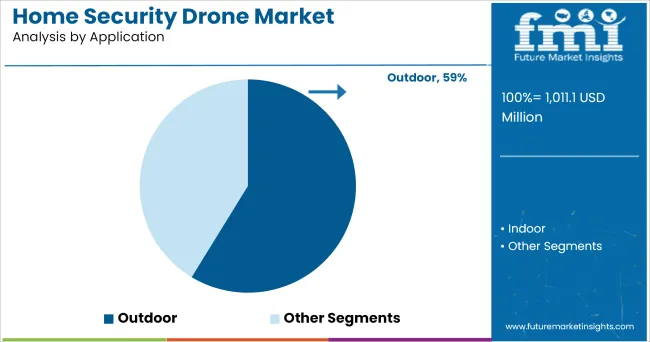
The Outdoor segment is projected to account for 58.7% of the home security drone market revenue in 2025, securing its role as the primary application segment. Growth of this segment has been driven by the need for enhanced security coverage of property exteriors, including yards, driveways, and perimeters.
Homeowners have adopted outdoor surveillance drones to monitor potential intrusion points, wildlife disturbances, and package deliveries, extending security coverage beyond the home’s interior. Manufacturers have optimized drones for outdoor use with features such as weather resistance, long-range connectivity, and autonomous flight paths capable of covering wide areas.
Consumer demand has particularly favored drones that integrate with home security systems, allowing for coordinated responses to detected movement or unusual activity. As the trend toward comprehensive residential security solutions continues, the Outdoor segment is expected to lead the market, driven by the increasing importance of proactive perimeter surveillance and situational awareness.
The introduction of technologically advanced products and promising growth rate of the drone market supplements the growth of the global home security drone market. Since they are able to fly at an altitude of 20 feet, pocket-sized drones can be used for security purposes and can capture an intruder's relevant identification information.
Plus, these gadgets are equipped with built-in biometric scanning so that burglars can't operate or steal them. Such devices can be remotely operated by users through radio controllers or smartphones with USB ports, which is in turn is likely to augment the market growth over the forecast period.
Moreover, drones used in security for next-generation are of gen-7 named as a solo drone with highly accurate sensors built-in, using smart technology, and having real-time monitoring feature would provide new opportunities in every sector.
The fixed-wing drone is gaining traction, owing to factors such as longer flight autonomy, larger areas covered in less time, better quality of the photographic result, and better control of flight parameters.
In addition, the fixed wing drone allows to monitor automatically and in real time the image quality, making possible, if necessary, to interrupt the flight and then restart it from the precise shooting point of the image that has not the required quality.
Fixed-wing drone relies on its long titled wings to create a life effect while cruising and does not need much battery to stay aloft since the lift effect is passive.
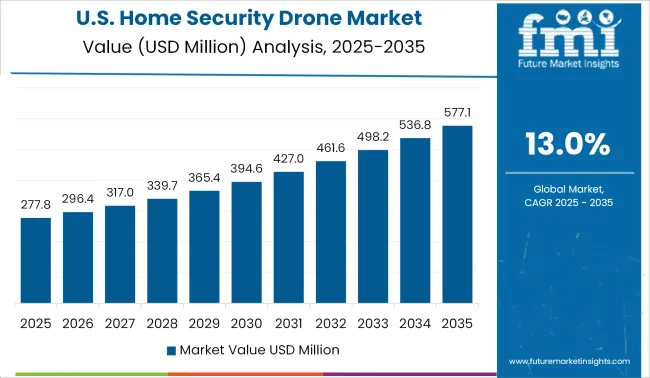
North America is expected to be the largest and fastest-growing market for home security drones during the forecast period, owing to increasing adoption of drones for numerous monitoring and surveillance applications in the region. In addition, government of various countries are offering relief for the usage of the drone in the region.
Moreover, advancements in drone technologies have allowed manufacturers to produce a wide range of models in different sizes, weights, and shapes, which can carry different sensor payloads, making them favorable across the residential sector.
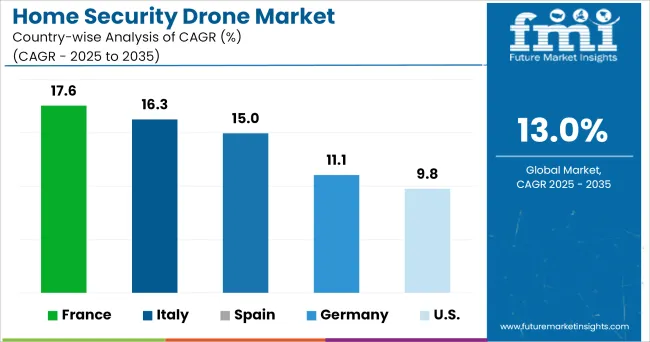
The home security drone market in the Europe region is estimated to expand at a significant rate and projected to dominate the global market between 2024 & 2035. The changes in drone regulations made by the European Union Aviation Safety Agency (EASA) are supporting the deployment of drones in various sectors, like infrastructure, agriculture, residential, transport, entertainment, and security.
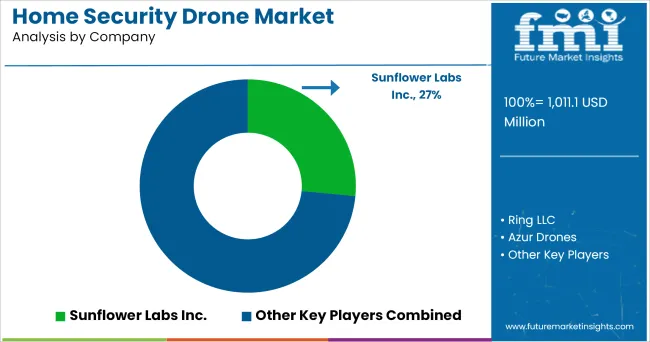
Some of the leading providers of Home Security Drone include
These vendors are adopting different strategies for enhancing the customer base and their product offering locally and globally. Companies are also investing millions of dollars into research and development activities to fulfill the unmet needs of their customers. Furthermore, many companies are focusing on inorganic strategies by acquiring small and mid-sized organizations present in this market.
The report is a compilation of first-hand information, qualitative and quantitative assessment by industry analysts, inputs from industry experts and industry participants across the value chain.
The report provides in-depth analysis of parent market trends, macro-economic indicators and governing factors along with market attractiveness as per segments. The report also maps the qualitative impact of various market factors on market segments and geographies.
The global home security drone market is estimated to be valued at USD 1,011.1 million in 2025.
The market size for the home security drone market is projected to reach USD 3,432.1 million by 2035.
The home security drone market is expected to grow at a 13.0% CAGR between 2025 and 2035.
The key product types in home security drone market are rotary-wing drone, fixed-wing drone and hybrid drone.
In terms of application, outdoor segment to command 58.7% share in the home security drone market in 2025.






Full Research Suite comprises of:
Market outlook & trends analysis
Interviews & case studies
Strategic recommendations
Vendor profiles & capabilities analysis
5-year forecasts
8 regions and 60+ country-level data splits
Market segment data splits
12 months of continuous data updates
DELIVERED AS:
PDF EXCEL ONLINE
Home Sleep Screening Device Market Size and Share Forecast Outlook 2025 to 2035
Home Healthcare Software Industry Analysis in North America Size and Share Forecast Outlook 2025 to 2035
Home Decor Market Size and Share Forecast Outlook 2025 to 2035
Home Automation Sensors Market Size and Share Forecast Outlook 2025 to 2035
Home Energy Management Systems Market Size and Share Forecast Outlook 2025 to 2035
Home Dialysis Systems Market Size and Share Forecast Outlook 2025 to 2035
Home Standby Gensets Market Size and Share Forecast Outlook 2025 to 2035
Home Scales Market Size and Share Forecast Outlook 2025 to 2035
Home Gym Equipment Market Size and Share Forecast Outlook 2025 to 2035
Home Brewing Systems Market Size and Share Forecast Outlook 2025 to 2035
Home Brew Boiler Market Size and Share Forecast Outlook 2025 to 2035
Home Infusion Therapy Devices Market Analysis - Size, Share, and Forecast Outlook 2025 to 2035
Home Healthcare Market Analysis - Size, Share, and Forecast Outlook 2025 to 2035
Homeopathic Products Market Analysis - Size, Share, & Forecast Outlook 2025 to 2035
Home Care Services Market Size, Growth, and Forecast 2025 to 2035
Home Sleep Apnea Testing Market Analysis - Size, Share, and Forecast Outlook 2025 to 2035
Home Office Spending Market by Solution Deployment, Application & Region Forecast till 2025 to 2035
Home Baking Ingredients Market Growth - Consumer Trends 2025 to 2035
Home Respiratory Therapy Market – Growth & Forecast 2025 to 2035
Home Blood Testing Devices Market Insights - Trends, Growth & Forecast 2025 to 2035

Thank you!
You will receive an email from our Business Development Manager. Please be sure to check your SPAM/JUNK folder too.
Chat With
MaRIA